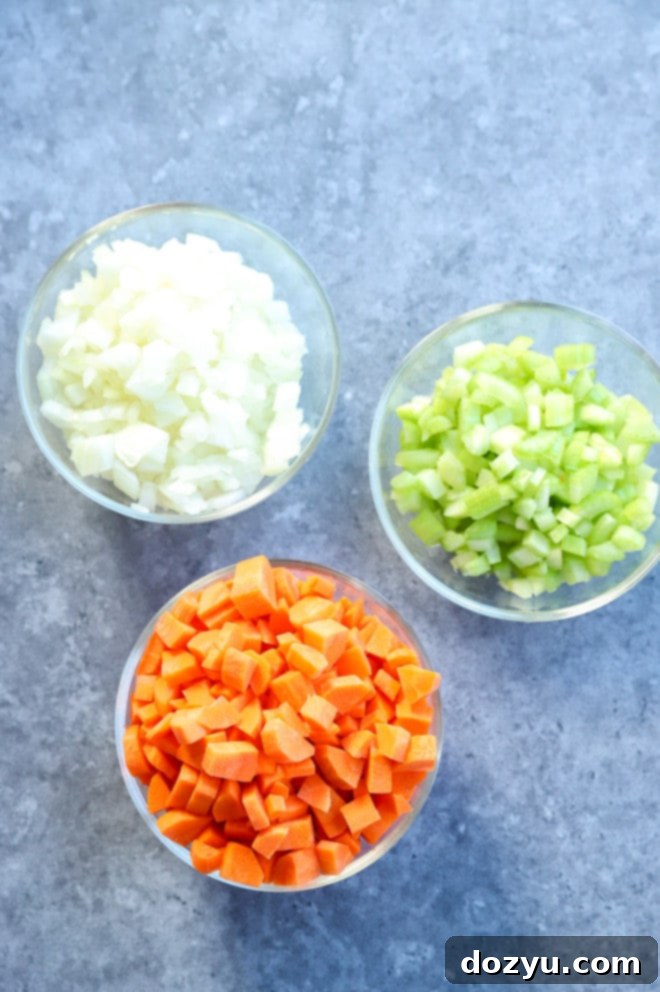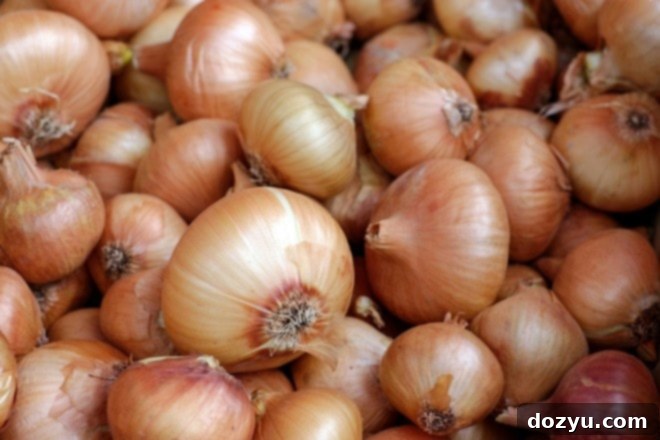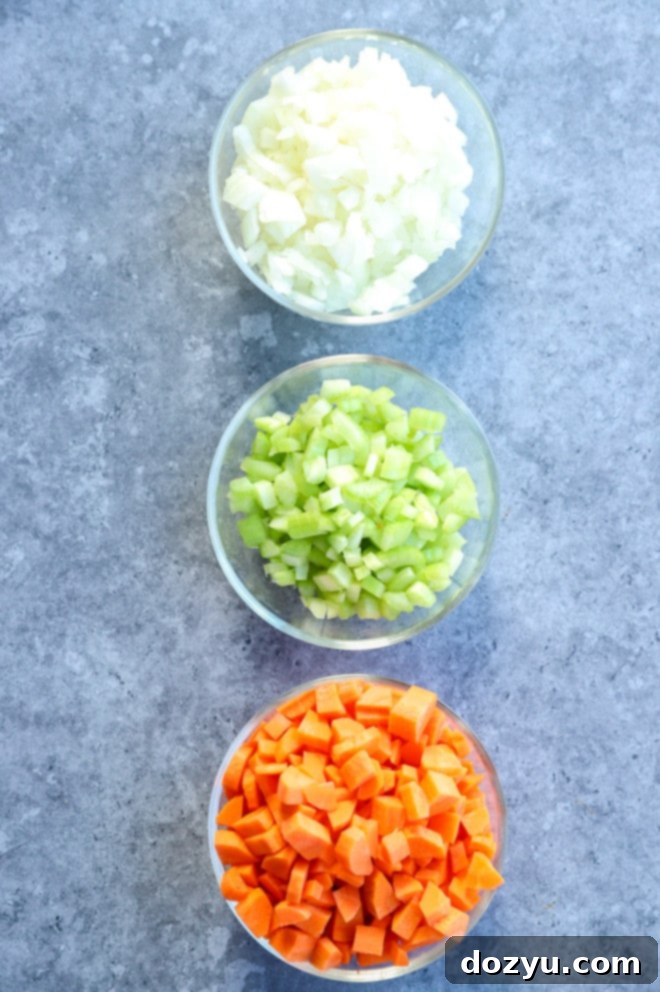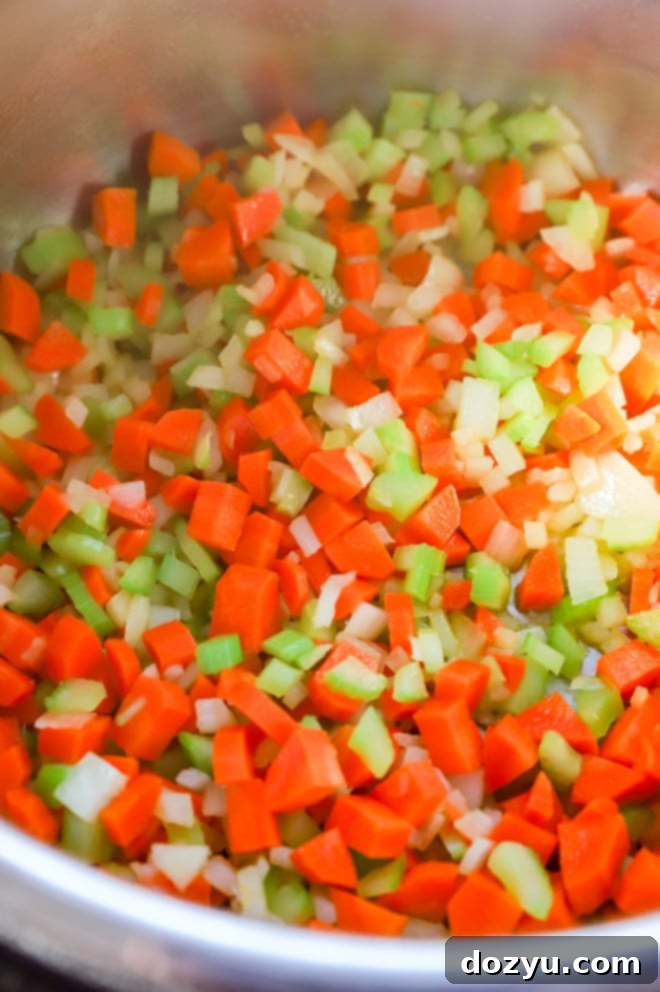Mastering Mirepoix: Your Essential Guide to This French Culinary Foundation
A Mirepoix recipe is more than just a combination of vegetables; it’s a foundational aromatic base in classical French cuisine, bringing depth and complexity to countless dishes. This comprehensive guide will teach you how to easily create this flavorful trio of onions, carrots, and celery, along with expert tips on preparation, variations, and efficient freezing techniques to streamline your cooking. Master the art of mirepoix and elevate your homemade meals!

Table of Contents
Toggle
About This Mirepoix Recipe
While the concept of simply cooking vegetables might not sound revolutionary, the humble mirepoix is a true unsung hero of the culinary world. This aromatic blend of onions, carrots, and celery forms the backbone of flavor for an astonishing array of dishes. From hearty soups and rich stews to delicate sauces and succulent braised meats, a well-prepared mirepoix adds a depth and sweetness that cannot be replicated. Rather than opting for pre-made, often pricier and less flavorful, frozen versions, learning to make your own mirepoix from scratch is a simple, cost-effective, and deeply rewarding skill.
One of the greatest advantages of making mirepoix at home is the ability to prepare it in advance. This vegetable base can be easily chopped and frozen, serving as a convenient meal-prep shortcut for busy weeknights. When stored correctly, a homemade mirepoix can last for up to 6 months in the freezer, significantly cutting down on daily cooking time. Imagine effortlessly adding a boost of fresh flavor to your favorite recipes without the fuss of chopping fresh vegetables every time! This guide will walk you through everything you need to know, ensuring your mirepoix is always perfect and ready to transform your cooking.
What Exactly Is Mirepoix?
At its heart, mirepoix (pronounced meer-PWAH) is a classic French culinary term referring to a flavor base made from diced onions, carrots, and celery, cooked gently in butter or oil. This trinity of aromatic vegetables is considered the starting point for countless traditional French recipes, laying down a robust foundation of savory, sweet, and slightly earthy notes. The traditional ratio for a mirepoix is often cited as two parts onion, one part carrot, and one part celery. This particular balance ensures that the onion’s pungent sweetness is prominent, rounded out by the earthiness of carrots and the distinct savory notes of celery.
The magic of mirepoix lies in its cooking method. Unlike caramelizing, where vegetables are browned to develop deep, complex sugars, mirepoix is typically “sweated” over medium-low heat. This means cooking the vegetables slowly until they soften and become translucent, releasing their aromatic compounds and natural sugars without developing a significant brown color. This gentle cooking process extracts maximum flavor, creating a mild, sweet, and aromatic base that enhances, rather than overwhelms, the main ingredients of a dish. Once the mirepoix is sweated, it can be built upon by adding ingredients like tomato paste for richness, broth for soups, or even chopped meats like pancetta or bacon for a more savory starting point, depending on the specific recipe you are creating.

Exploring Mirepoix Variations
While the French mirepoix holds a special place in classic cooking, it’s fascinating to see how other culinary traditions have developed their own aromatic foundations. These regional variations often use different combinations of vegetables and sometimes even different cooking techniques, reflecting local produce and flavor preferences. Understanding these “aromatic bases” can broaden your cooking horizons and allow you to experiment with diverse global flavors:
- Mirepoix (French): The classic combination of onion, carrot, and celery. It’s sweated gently to create a sweet, savory, and aromatic base, crucial for stocks, soups, and sauces.
- The Holy Trinity (Cajun/Creole): A staple in Louisiana cuisine, this vibrant base consists of onion, celery, and green bell pepper. It provides a bolder, slightly spicier, and more herbaceous flavor profile, essential for gumbos, jambalayas, and étouffées.
- Soffritto (Italian): Similar to French mirepoix, Italian soffritto typically includes finely chopped onion, carrot, and celery, often with the addition of fresh parsley. It’s usually cooked slowly in olive oil to achieve a deep, concentrated flavor, forming the base for pasta sauces, risottos, and stews.
- Sofrito (Latin American/Spanish): This term encompasses a wide range of regional variations but commonly features onion, garlic, bell peppers (often red or green), and tomatoes, sometimes blended into a paste. Sofrito is typically sautéed until fragrant and deeply flavored, providing a rich, vibrant base for dishes across Latin America, the Caribbean, and Spain.
Each of these variations showcases the art of building flavors from the ground up, proving that a thoughtful combination of simple ingredients can transform a dish. For an added layer of sophistication in your classic mirepoix, consider incorporating a finely minced shallot. Shallots offer a more delicate, sweeter, and less pungent flavor than regular onions, which can add a nuanced depth to your mirepoix and the final recipe.

Key Mirepoix Ingredients
The beauty of mirepoix lies in its simplicity, requiring just a few fresh ingredients to create a powerful flavor foundation. Here’s a closer look at the key components:
Onion: The backbone of the mirepoix, contributing sweetness and a robust aromatic profile. While traditional recipes often call for white onions due to their mildness and clean flavor, yellow onions are a popular and excellent choice, offering a balanced sweetness and pungency. For an even sweeter touch, especially in dishes where you want a less assertive onion flavor, sweet Vidalia or Walla Walla onions can be used. The type of onion can subtly influence the final taste of your dish, so feel free to experiment.
Carrots: These vibrant root vegetables bring natural sweetness and a subtle earthiness to the mix. Standard orange carrots are perfect, but you could also explore using rainbow carrots for a touch of visual flair, though their flavor contribution will be largely similar. Always peel your carrots to ensure a smooth texture and remove any bitterness from the skin.
Celery: Offering a distinct savory, slightly peppery, and herbaceous note, celery adds a crucial layer of flavor that rounds out the sweetness of the onions and carrots. It’s essential to clean celery very thoroughly, as dirt often clings within the stalks, especially in the inner crevices. A good rinse and scrub under running water, followed by trimming any tough ends or leaves, will ensure a clean flavor.
Butter or Oil: The fat used to cook your mirepoix plays a vital role in extracting and carrying the flavors of the vegetables. Unsalted butter adds a rich, creamy depth and a classic French touch. Alternatively, a good quality cooking oil, such as olive oil (extra virgin for flavor, or a lighter variety for a neutral base), canola oil, or even avocado oil, works perfectly. Using a combination of butter and oil is also a popular technique, blending the richness of butter with the higher smoke point of oil.

Essential Equipment for This Recipe
To prepare your mirepoix efficiently and effectively, having the right tools makes all the difference. While the recipe itself is straightforward, precise chopping is key for even cooking and consistent flavor. Therefore, a high-quality chef’s knife and a sturdy cutting board are truly indispensable. These tools will allow you to quickly and safely dice your vegetables into uniform pieces, a critical step for a perfect mirepoix.
For the cooking stage, you will need either a large skillet or a deep pot, such as a Dutch oven. The choice often depends on the subsequent recipe you plan to make. If your mirepoix is the initial step for a stew or braise, starting it directly in your Dutch oven saves you from transferring ingredients later. Ensure your chosen pan is large enough to comfortably accommodate all the vegetables without overcrowding, which is essential for proper “sweating” rather than steaming or browning.

Step-by-Step: How to Make Mirepoix
Making mirepoix is a fundamental skill that will elevate your home cooking. Follow these simple steps for a perfect aromatic base every time:
Prepare the Vegetables
Begin by meticulously preparing your vegetables. For the onions, remove the papery outer skin and trim both the root and stem ends. For carrots, use a vegetable peeler to remove the outer layer. Celery stalks require thorough cleaning; rinse them well under cold water, paying attention to any dirt lodged in the inner curves, and trim off the fibrous ends and any leaves. This initial preparation is crucial for a clean, fresh-tasting mirepoix.
Chop the Vegetables Evenly
The key to a successful mirepoix is uniform dicing. Chop all the vegetables – onions, carrots, and celery – into approximately 1/2-inch (about 1.25 cm) pieces. This standard size ensures that all vegetables cook evenly and release their flavors at a similar rate. For most soups, stews, and sautéed dishes where the vegetables are intended to hold some shape, this size is ideal. However, if your recipe calls for blending the mirepoix later into a smooth sauce or creamy soup, you can opt for slightly larger chunks, around 1-inch (2.5 cm), as precise uniformity is less critical.
Planning to Freeze? If you intend to freeze your mirepoix for future use, this is the moment to do so. We highly recommend freezing the vegetables *before* cooking them. Cooked onions and celery, in particular, tend to become excessively mushy and lose their desirable texture during the freezing and reheating cycle. Freezing raw, pre-chopped mirepoix ensures that when you’re ready to cook, the vegetables retain their integrity and fresh flavor, ready to be properly sweated as the vibrant base for your dish.
Cook to Perfection
Heat your chosen fat – olive oil, butter, or a combination – in a large skillet or pot over medium-low heat. The goal here is gentle cooking. Once the fat is shimmering (if oil) or melted (if butter), add the uniformly chopped onion, carrot, and celery mixture. Cook, stirring frequently, for approximately 10 to 12 minutes, or until the vegetables have softened significantly and the onions have become translucent. It’s crucial during this stage to prevent the vegetables from browning or caramelizing. If you notice any signs of browning, immediately reduce the heat. The objective is to “sweat” the vegetables, allowing them to release their moisture and aromatic compounds slowly, building a deep, sweet, and savory foundation without the intense, toasted notes that come from caramelization.
Expert Tips and Creative Variations
Mastering mirepoix is all about technique and understanding how these core ingredients interact. Here are some pro tips and ideas for variations to enhance your culinary journey:
Chop Everything Evenly: This cannot be stressed enough. While you don’t need to be a Michelin-star chef, striving for roughly the same size (e.g., 1/2-inch dice) for all your vegetables is crucial. Uniformity ensures that they cook at the same rate, preventing some pieces from becoming mushy while others remain raw. Consistent dicing guarantees an even release of flavors and a harmonious texture in your final dish.
Do Not Brown the Vegetables: The purpose of mirepoix is to create an aromatic base by “sweating” the vegetables, not caramelizing them. Browning would lead to a deeper, sweeter, and sometimes slightly bitter flavor profile, which is not what you want for a classic mirepoix. Keep the heat on medium-low and stir often. If you see any browning begin, reduce the heat immediately. The goal is soft, translucent vegetables that have released their natural sugars and aromas, infusing your cooking with subtle, nuanced flavor.
Use the Right Size Pan: Overcrowding your pan is a common mistake. When too many vegetables are packed into a small pan, they tend to steam rather than sweat. This prevents proper moisture evaporation and flavor development. Always use a pan large enough to allow the vegetables to spread out in a single, or at most, a thin double layer. If you’re making a larger batch, it’s always better to cook the mirepoix in two separate batches to ensure even contact with the heat and proper sweating.
Experiment with Additional Aromatics: While the classic trio is perfect, don’t hesitate to introduce other aromatic vegetables to tailor your mirepoix to specific dishes. Consider adding:
- Garlic: A clove or two, minced and added in the last few minutes of cooking, provides a pungent kick.
- Shallots: For a more refined, delicate onion flavor, shallots can replace a portion of the onion.
- Leeks: The white and light green parts of leeks offer a milder, sweeter onion flavor and can be used in combination with or instead of some onion, especially for lighter broths.
- Fennel: When diced and sweated, fennel offers a subtle anise flavor that can be fantastic in fish stews or Mediterranean-inspired dishes.
- Parsnips: These root vegetables add a deeper, earthier sweetness, excellent for heartier winter stews.
- Bell Peppers: As seen in the “Holy Trinity,” bell peppers can add a fresh, vibrant, and slightly sweet-peppery note.
Incorporate Herbs and Spices: To further enhance your mirepoix, you can introduce dried or fresh herbs during the sweating process. A bay leaf, a few sprigs of fresh thyme or rosemary, or a pinch of black peppercorns can be added with the vegetables. These will gently infuse their flavors into the fat and vegetables, building an even more complex aromatic base for your dish.
Ready to put your mirepoix to good use? Explore these delicious recipes: Instant Pot Chicken Stew | Tuscan White Bean Stew | Short Rib Ragu

What Can Substitute Celery in Mirepoix?
If you find yourself without celery, or simply aren’t a fan, there are indeed viable substitutes that can still provide an aromatic foundation for your dish, though the flavor profile will shift slightly. The most common and effective substitute, especially if you’re leaning into a different regional cuisine, is green bell pepper. Swapping celery for green bell pepper transforms your mirepoix into the “Holy Trinity,” a cornerstone of Cajun and Creole cooking, imparting a distinctive, slightly more herbaceous and vibrant flavor.
Other potential substitutes, depending on the desired outcome, include:
- Parsnips: For a sweeter, earthier note, especially good in winter soups and stews.
- Fennel: Offers a subtle anise flavor, great for Mediterranean-inspired dishes.
- Zucchini: While less traditional, finely diced zucchini can add moisture and a very mild flavor if you need a neutral vegetable to fill the gap.
Keep in mind that each substitute will alter the overall flavor, so choose one that complements your final dish.
Can You Freeze Mirepoix? Yes!
Absolutely, freezing mirepoix is one of the best ways to practice efficient meal prep and save precious time in the kitchen! Having pre-portioned mirepoix ready in your freezer means you’re just minutes away from starting a flavorful soup, stew, or sauce on even the busiest weeknights. However, the key to successful freezing lies in *when* you freeze it.
We strongly recommend freezing the vegetables before cooking them. Cooked onions and celery, in particular, contain a high water content and tend to become quite mushy and lose their desirable texture when subjected to the freezing and reheating process. Freezing them raw preserves their crispness and allows them to be properly sweated and softened when you’re ready to use them, extracting maximum fresh flavor for your recipe.
If you do happen to have leftover cooked mirepoix, don’t despair! It can still be frozen and put to excellent use in recipes where texture isn’t a primary concern. Think blended dishes like creamy butternut squash soup or pumpkin and sweet potato soup. In these applications, the softened texture of the thawed vegetables won’t be an issue, as they will be puréed anyway. Uncooked mirepoix can be frozen for up to 6 months, while cooked mirepoix is best used within 3 months for optimal quality.
Can I Double This Mirepoix Recipe?
Yes, you can absolutely make a double (or even triple) batch of this mirepoix recipe! This is a fantastic strategy for meal prep, allowing you to have a larger supply ready for multiple future meals. The most crucial factor when scaling up the recipe is to ensure you have a skillet or pot large enough to accommodate the increased volume of vegetables without overcrowding. If your pan isn’t sufficiently large, it’s better to cook the mirepoix in multiple batches to ensure the vegetables properly sweat and don’t steam, which would compromise the flavor and texture of your aromatic base.
Can I Add Other Vegetables to Mirepoix?
While the classic French mirepoix strictly adheres to the onion, carrot, and celery trio, the culinary world is full of flexibility! You can certainly incorporate other aromatic vegetables to enhance the depth and complexity of your base, or to adapt it to a specific dish’s flavor profile. Experimenting with additions like finely diced shallots, leeks, fennel, or even a touch of garlic can introduce exciting new dimensions. Think about the final dish you’re preparing; for a heartier, more rustic flavor, consider parsnips. For a slightly different aromatic twist, bell peppers are a common addition in other regional flavor bases like the “Holy Trinity.” The beauty of mirepoix lies in its adaptability; feel free to get creative and customize it to your taste!
Need some inspiration for dinner this week? Check out my dinner recipes page for more delicious ideas!

Delicious Ways to Use Mirepoix
Mirepoix is the secret ingredient behind many of your favorite comfort foods and gourmet dishes. Once you have a batch ready, whether fresh or frozen, the possibilities are nearly endless. Here are some of our absolute favorite applications:
- Soups and Stews: This is arguably where mirepoix shines brightest. It provides a savory-sweet depth that forms the perfect foundation for everything from a light vegetable broth to a rich, hearty beef stew. Our Tuscan White Bean Stew is a prime example, packed with flavor and wholesome ingredients like white beans and kale, all starting with a fragrant mirepoix.
- Braised Meats: For tender, fall-off-the-bone results, mirepoix is essential. It infuses braising liquids with incredible flavor, transforming cuts like short ribs or pot roasts. Try our Instant Pot Short Rib Ragu, where the mirepoix builds an unmatched depth of flavor under pressure.
- Sauces and Gravies: Mirepoix can be the initial step for a classic brown gravy, a béchamel sauce, or a rich demi-glace. It contributes a foundational flavor that deepens the overall profile.
- Risottos and Grains: For an incredibly flavorful risotto or other grain dishes like pilafs, sautéing mirepoix before adding rice or grains creates a delightful aromatic base. A roasted vegetable risotto truly comes to life with this aromatic start.
- Casseroles and Bakes: Adding a layer of sweated mirepoix to the base of your casseroles, gratins, or baked pasta dishes will elevate them from simple comfort food to something truly special.
- Stuffings and Dressings: For holiday meals, a well-made mirepoix is indispensable in creating a savory and aromatic stuffing for poultry or a flavorful dressing.
- Meatloaf and Meatballs: Finely minced and sweated mirepoix can be mixed directly into ground meat for meatloaf, meatballs, or even burger patties, adding moisture, flavor, and vegetable goodness.
No matter the dish, starting with a carefully prepared mirepoix sets the stage for a truly memorable culinary experience.
Storage and Reheating Instructions
Proper storage is essential to extend the life of your mirepoix, whether cooked or uncooked, and to maximize its convenience for future meals.
Store Cooked Mirepoix. Allow any cooked mirepoix to cool completely to room temperature before transferring it to an airtight container. Store it in the refrigerator, where it will remain fresh for about 2 to 3 days. This is perfect for using in recipes within a short timeframe.
Reheat Cooked Mirepoix. To reheat cooked mirepoix, simply add it to a skillet or pot over medium-low to medium heat. Stir occasionally until it is warmed through. You can also incorporate it directly into a simmering soup or stew, allowing it to warm up as part of the dish.
Freeze Uncooked Mirepoix. For long-term storage and ultimate meal prep convenience, freeze mirepoix *before* cooking. This prevents the vegetables, particularly onions and celery, from becoming mushy during thawing and reheating. Dice your onions, carrots, and celery into your preferred uniform size. Then, transfer the chopped vegetables to an airtight freezer-safe container or a heavy-duty resealable freezer bag. Ensure you remove as much air as possible from the bag to prevent freezer burn. Label with the date and freeze for up to 6 months. When ready to use, thaw overnight in the refrigerator or add directly to your hot pan for sweating if using in soups or stews.
Freeze Cooked Mirepoix (for blended dishes). If you have cooked mirepoix leftovers, you can still freeze them, but bear in mind the textural change. Allow it to cool completely, then place it in a resealable freezer bag or an airtight freezer-safe container. Freeze for up to 3 months. This frozen cooked mirepoix is best used in blended recipes like puréed soups or smooth sauces, where the softened texture won’t be an issue.
Thaw. To thaw frozen mirepoix (raw or cooked), the best method is to transfer it to the refrigerator overnight. For raw mirepoix, you can sometimes add it directly to a hot pan to begin cooking, though it may take a few extra minutes to soften. Once thawed, use it as your recipe instructs, or reheat cooked mirepoix as described above.
Finally, if you make this mirepoix recipe, please be sure to give this recipe a star rating on the recipe card and/or leave a comment! I love to hear when you all make recipes, and I do take the time to respond to every single comment.
Feel free to drop questions below too, if you have them!
Oh and be sure to tag me on Instagram if you make the recipe! I love being able to see these recipes come to life in your homes – it’s my favorite thing to look through those photos. It really means the world to me!

How to Make Mirepoix
Equipment
-
Wusthof Chef’s Knife
-
Organic Bamboo Cutting Board
-
Large Nonstick Skillet
-
Dutch Oven (optional, for larger batches)
Ingredients
- 2 cups yellow or white onions diced into 1/2-inch pieces
- 1 cup celery diced into 1/2-inch pieces, thoroughly cleaned
- 1 cup carrots peeled and diced into 1/2-inch pieces
- 1 Tbsp olive oil or unsalted butter or a combination
Instructions
-
Heat the olive oil or unsalted butter in a large skillet or pot over medium-low heat. Ensuring the heat is not too high is key to preventing browning.
-
Once the oil is shimmering or the butter is melted, add the uniformly chopped onions, celery, and carrots. Cook, stirring frequently and gently, until the vegetables are softened and the onions appear translucent. This process typically takes about 10 to 12 minutes. Be vigilant to ensure the vegetables do not brown or caramelize; if you notice any browning beginning, reduce the heat immediately. The goal is to “sweat” the vegetables, releasing their sweet and aromatic compounds without developing a toasted flavor.
